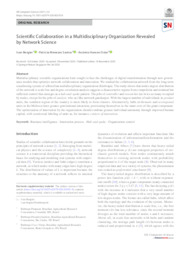Scientific collaboration in a multidisciplinary organization revealed by network science.
Scientific collaboration in a multidisciplinary organization revealed by network science.
Author(s): BERGIER, I.; SANTOS, P. M.; OSTER, A. H.
Summary: Multidisciplinary scientific organizations have sought to face the challenges of digital transformation through new govern-ance models that optimize network collaboration and innovation. We studied the collaboration network from the long-term coauthoring system of a Brazilian multidisciplinary organization (Embrapa). The study shows that nodes degree distribution of the network is scale free and degree correlation analysis suggests a disassortative regime from competition and minimal but sufficient control that emerges as a hub-and-spoke pattern. The jobs of controller and researcher are twice as many occupied by males, except for the jobs of analyst, who act like network gatekeeper. With the largest number of individuals in productunits, the southern region of the country is more likely to form clusters. Alternatively, hubs in thematic and ecoregionalunits in the Midwest have greater gravitational attraction, positioning themselves in the inner core of the giant component. The optimization of innovation by the organization should combine greater individual autonomy through improved human capital, with a universal labeling of units as, for instance, centers of innovation.
Publication year: 2021
Types of publication: Journal article
Unit: Embrapa Grape & Wine
Observation
Some of Embrapa's publications are published as ePub files. To read them, use or download one of the following free software options to your computer or mobile device. Android: Google Play Books; IOS: iBooks; Windows and Linux: Calibre.
Access other publications
Access the Agricultural Research Database (BDPA) to consult Embrapa's full library collection and records.
Visit Embrapa Bookstore to purchase books and other publications sold by Embrapa.

